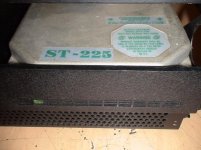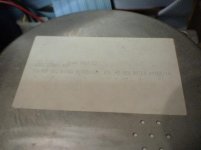Old hard drives are a lot like old cars -- it comes down to preventative maintennance. One of the biggest preventative measures that people today often forget to do is to park the heads before shutting it down. You just flick the power switch without parking, you risk damaging the data on the sector, or even worse physically damaging the media.
Mechanically there's no reason for a ST-225, 238 or 251 (all really the same spindle and head mechanisms) to fail within the average person's lifetime if it's taken care of. Even drives with bad and physically damaged sectors can often be brought back from the dead so long as track 1 is intact just by using a drop of 3-in-1 under the ground strap to the spindle and a quick run-through with spinrite to mark off any dead/damaged sectors it may have gained.
Literally one drop of oil on the bearing (which draws in via capillary action) can quiet the noisest old MFM/RLL Seagate for years and add years to it's service life so long as the heads are still moving freely and aren't scraping on the media once it spins up... and when I say one drop, I mean one tiny drop and IMMEDIATELY flip the drive board-side down so gravity doesn't pool it into the drive (possibly spoiling the media). Capillary action will draw exactly the right amount up into the bearing... I like to let them sit for about an hour board down after applying the oil, then using a loose-cloth paper towel (like kleenex viva) to soak up any excess.
If you've never tried Viva, I HIGHLY suggest them over normal paper towels or shop-rags! Makes Bounty look like cheap garbage... and they can actually even survive a machine washing or two depending on what you use them for.
Notice how little oil I'm saying too - another place people screw up pouring it on there like they were watering a lawn; it's kind of like the people who use heat sink compound like they were frosting a cake.
... and CHRISTMAS ON A CRACKER WD-40 IS NOT A LUBRICANT!!!
I just needed to say that because I've lost track of the number of bearings I've seen burnt to a crisp (in general, from fans to hard drives... to bicycles; I do bike repairs on the side) because someone freed it up with WD-40 but then failed to give it any lubricant after. WD-40 dissolves rust and can free rusted/crusted/burnt joints/bearings, but it provides ZERO lubrication as it's a cleaner; in fact it dissolves away any grease/oil so basically you just washed away any existing lubricant!!! So many people treat it like it's lube, when you really need to get some oil in there once the WD-40 evaporates.
Typically the spindle/bearing for the heads doesn't need extra lube because it's greased (doesn't drain away), low cycle (compared to the platters) -- and once the drive spins up the heads aren't making contact with the medium so it's a very low friction environment... most common failure point is the platter spindle bearings... you take care of those with occasional lubrication (one drop of oil every two to three years), park the heads so you don't damage the media, don't drop them or run them on their side or upside-down, an old seagate MFM drive should last a lifetime.
Oh yeah, that's another place people often ruin the old drives; trying to run them on their side or upside-down -- they weren't designed for it and all the literature for them says don't do it! Board down metal cover up ONLY on the old drives. You run them on their nose (faceplate down) during park or seeks to the outer tracks it's possible for the drive to overseek past the media completely ruining the drive as the mechanical stop flexed with the added gravity... it's why some manuals for them say it's ok to run them nose-up, but not on their side, nose down or upside-down.
Which is part of the problem buying them used -- if you can find them in old machines they have likely only ever been used in, you're probably golden; bare drive of unknown history, it's a craps shoot... that gets worse and worse every year.




